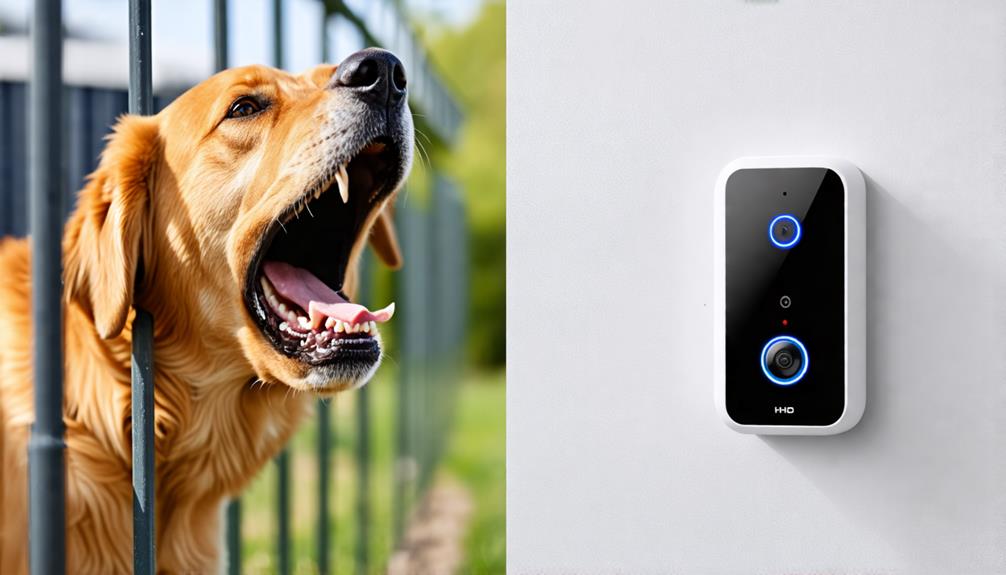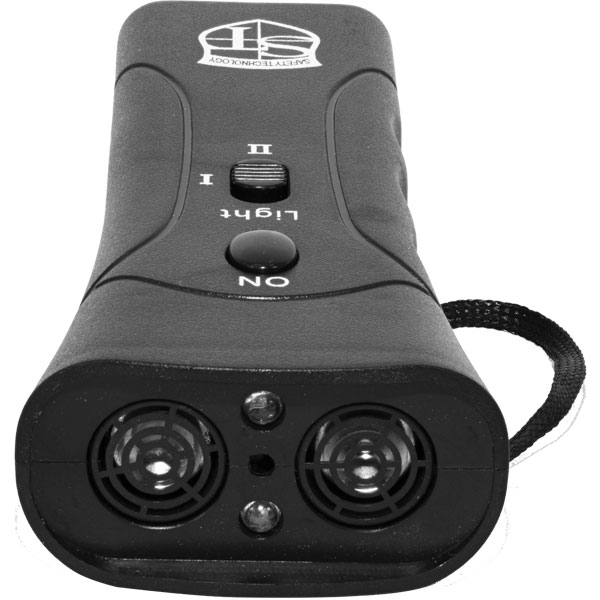
Brainstorm Security Shop

For Orders Over $199

On Any Of Our Products

Details On Refund Page
You’ve probably encountered those moments when an unwelcome dog decides your yard is their new favorite spot. Choosing the right dog repellent can be a delicate balance—after all, you’re aiming to deter, not harm. From the sharp scent of citronella sprays to the unseen boundaries set by ultrasonic devices, each type offers distinct advantages and challenges. But how do you decide which is most suitable for your needs without compromising the safety and well-being of the animal? Consider the implications of each method, and you might find that the answer isn’t as straightforward as you’d think.
There are several types of dog repellents you can choose from, depending on your specific needs. If you’re dealing with aggressive canines in your neighborhood or want to keep dogs off your lawn, understanding these options is crucial.
Firstly, you’ve got sprays and gels. These products usually contain natural ingredients like citronella and ammonia, which are known to deter dogs due to their strong scent. You can apply these directly to the areas you want to protect. Just make sure you’re reapplying them after rain or regular watering.
Ultrasonic devices are another route you can take. These gadgets emit high-frequency sounds that are irritating to dogs but are inaudible to humans. They’re particularly useful if you prefer a non-chemical approach. You’ll need to install these devices around your property where you’ve noticed frequent canine activity.
Another option is motion-activated sprinklers. These systems detect movement and spray water to scare away pets and wild animals alike. It’s a harmless way to keep dogs from entering your garden or yard.
Choosing the right dog repellent depends on your environment and how often you encounter these animals. Each type has its specific uses, so consider what fits best with your lifestyle and dog encounters.

Using dog repellents can significantly enhance your peace of mind by keeping unwanted canine visitors away from your property. Whether you’re dealing with a neighbor’s dog that constantly digs up your garden or a stray that’s taken a liking to your lawn, repellents provide a non-confrontational solution to discourage their presence.
You’ll find that these products not only help protect your property but also keep the dogs safe. Instead of facing potential harm from traffic or unfriendly encounters with other animals in your yard, dogs are naturally encouraged to stay away. This is particularly beneficial if you’re in an area with a lot of road traffic or other hazards that could pose a risk to wandering pets.
Moreover, using repellents means you’re less likely to have to deal with the aftermath of a dog visit—no more upset over destroyed plants, scattered trash, or other messes. They’re a proactive way to maintain your yard’s aesthetics and hygiene without resorting to harsh measures.
Chemical sprays offer a targeted and effective way to deter dogs from entering your property. These sprays contain specific ingredients that dogs find unpleasant, making them quick to learn that your space isn’t inviting. You’re likely curious about what’s in these sprays. Typically, they include natural components like citronella or capsaicin, which are safe but irritating to a dog’s senses.
When you’re using chemical sprays, it’s crucial to follow the directions closely. You’ll want to spray the perimeter of the area you’re protecting, ensuring that all entry points are covered. Remember, the goal isn’t to harm the dog but to make it associate your garden or yard with an undesirable smell.
It’s also important to note that weather conditions can affect the efficacy of these repellents. Rain can wash them away, and you’ll need to reapply them to maintain effectiveness. So, keep an eye on the weather forecast and plan your application accordingly.
Lastly, while these sprays are handy, they’re only part of a broader strategy. You’ll need to ensure that your yard doesn’t have attractions like open trash bins or pet food that might draw dogs in despite the repellent. Combining these tactics will provide the best defense against unwanted canine visitors.
Ultrasonic devices often serve as a non-invasive alternative to chemical repellents, deterring dogs using high-frequency sound waves that are inaudible to humans. These gadgets are simple to use and can be highly effective, especially in scenarios where you’re looking to avoid physical barriers or chemicals.
You’ll find these devices in various forms, including stationary units for gardens or driveways and portable models you can carry while walking or jogging.
When you activate an ultrasonic dog repellent, it emits a sound at a frequency typically above 20,000 Hz, which is beyond the range of human hearing but sensitive to a dog’s ears. This sound effectively annoys or scares the dog without causing any long-term harm. It’s a quick solution to discourage unwanted behavior like aggressive approaching or barking.
You might wonder about the range and effectiveness of these devices. Most models work effectively within distances of about 15 to 50 feet. However, environmental factors like wind or barriers might impact the device’s reach. Always ensure the device faces the direction of the approaching dog for optimal effectiveness.
If you prefer a gentler approach, consider natural dog repellents that utilize scents and substances dogs naturally avoid. You can harness the power of specific smells that dogs find unpleasant but are harmless and natural.
For instance, citrus fruits like lemons or oranges can be a good choice. Simply place peels or spritz some citrus oil around the areas you want to protect. Dogs generally dislike the sharp scent and will steer clear.
Another effective natural repellent is vinegar. Mixing apple cider vinegar with water in equal parts and spraying it around your garden can deter dogs without harming your plants. The strong smell dissipates quickly to human noses but remains potent enough to keep dogs away.
You can also try planting certain herbs. Lavender and peppermint aren’t only pleasant for humans but are also excellent dog deterrents. Plant these around your perimeter, or use essential oils derived from these plants for the same effect.
Lastly, coffee grounds spread around the soil can be effective. They add nutrients to your garden while keeping roaming dogs at bay with their robust smell. This dual-purpose solution is especially appealing if you’re also a coffee lover.

While exploring natural dog repellents, it’s crucial to always consider the safety of both pets and humans in your environment. You’ll want to be sure that what you’re using to deter dogs isn’t inadvertently harming other animals or people.
It’s essential to understand that even natural ingredients can be potent and sometimes toxic if misused. For example, certain essential oils, while effective at keeping dogs away, can be extremely harmful if ingested by pets or even inhaled by asthmatics.
You should always research and verify the safety of any substance before using it around your home or garden. Make sure you’re using the correct concentrations and applying the repellents in places that minimize accidental exposure.
Also, consider the long-term environmental impact of the repellents you choose. Some substances mightn’t only affect the local wildlife but could also seep into groundwater or affect the soil composition. Always opt for solutions that offer a balance between efficacy and ecological responsibility.
Lastly, keep in mind that what’s safe for one type of animal mightn’t be safe for another. Always monitor the effects of any repellent you use, and don’t hesitate to consult with a veterinarian if you’re unsure about the potential impacts on your pets’ health.
To select the most effective dog repellent, consider your specific situation and the behavior of local dogs. Are you dealing with aggressive strays in an urban setting or perhaps overly curious canines in rural areas? Your choice hinges on these factors.
If you’re often outdoors, a portable repellent is ideal. Sprays are common and can be directed towards an approaching dog, providing a barrier of protection. Look for products with ranges that suit your typical encounter distances.
For gardeners, granular repellents scattered around the perimeter can help keep pets from trampling your flowers without constant supervision. Consider the application frequency too. Some repellents require daily application, while others might last weeks. If you’re not keen on regular upkeep, opt for long-lasting options.
Also, think about the sensory impact. Some repellents emit sounds, others rely on olfactory deterrents. What’s tolerated well in a spacious backyard mightn’t be suitable for a compact apartment area where neighbors could be affected.
Lastly, ease of use matters. You’ll want something straightforward, especially in stressful situations. Complicated devices can become more of a hassle than a help. Choose wisely to ensure you’re not only protected but also comfortable with your repellent method.

Although dog repellents can be highly effective, their success often depends on the specific situation and dog behavior. You’ll find that factors such as the dog’s size, breed, and temperament can influence how well a repellent works. If you’re dealing with an aggressive breed or a particularly stubborn dog, you mightn’t see the results you’re hoping for. It’s crucial to understand these limitations to set realistic expectations.
Moreover, environmental conditions play a huge role. In windy or rainy weather, many spray-based repellents lose their effectiveness because the elements dilute or disperse them too quickly. You’ve got to consider this when deciding whether to use sprays or opt for more robust solutions like ultrasonic devices, which aren’t affected by weather.
Remember, consistency is key. Repellents aren’t a one-and-done solution. You’ll need to apply them regularly to maintain their effectiveness. Skipping days or not following the product instructions reduces their reliability.
Lastly, be aware that not all dogs react the same way to a specific repellent. What deters one mightn’t bother another at all. It’s often a process of trial and error to find the most effective method for your particular situation. Always monitor the dog’s behavior and adjust your approach accordingly.

You’ve explored various dog repellents, from chemical sprays to ultrasonic devices and natural solutions. Each offers unique benefits and limitations, so consider your specific needs and safety concerns.
Whether you opt for the immediacy of chemical options, the silence of ultrasonic tools, or the gentleness of natural repellents, choosing the right one ensures peace for both you and the dogs.
Remember, effectiveness varies, so select wisely to maintain harmony in your environment.

Brainstorm Security Shop
1867 Caravan Trail
Ste 105
Jacksonville, FL 32216
Call us toll free: (800) 859-5566